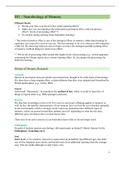Summary
Summary MLE Course: Memory Module Exam
- Course
- Institution
My summary got me an 8.3 on the memory exam, as part of the MLE course of the Brain and Cognition Specialization. By studying with my notes, you won't need to consult the lectures or any other materials. I include screenshots of the slides, plenty of images alongside concepts for better understandi...
[Show more]



